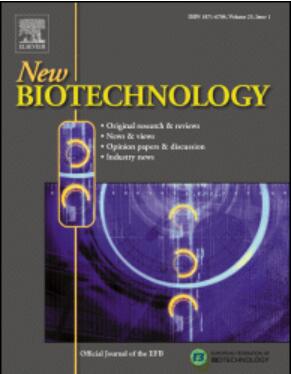培养基组成及重复使用对黄斑紫菜生长的影响
IF 4.9
2区 生物学
Q1 BIOCHEMICAL RESEARCH METHODS
引用次数: 0
摘要
这项研究的目的是开发一种以肥料为基础的培养基,以降低生产成本,并提高生产具有商业价值的红色海洋微藻——cruentum卟啉藻的可持续性。此外,还评估了水循环对微藻生长的影响。总体而言,氮源显著影响生物量生长,硝酸钠支持更高的生物量生产力(0.23 g·L−1·day−1),超过亚硝酸钠(0.18 g·L−1·day−1)和氯化铵(0.14 g·L−1·day−1)。尿素对生长有负面影响。与所研究的较低比例(8:1)相比,氮磷摩尔比为20:1的生物量生产力提高了约24% %,同时也减少了对磷的需求。最佳培养基组成为:1.75 g·L−1 NaNO3、0.23 g·L−1 K2HPO4·3 H2O、0.04 g·L−1 CaCl2、0.49 g·L−1 MgSO4·7 H2O和24.0 mg·L−1 Karentol®。最后,水的再利用对生物量浓度产生了负面影响,促进了细胞外有机碳和细菌的积累,并增加了培养物的粘度和浊度。本文章由计算机程序翻译,如有差异,请以英文原文为准。
Effect of culture medium composition and reuse on the growth of Porphyridium cruentum
The aim of this study was to develop a fertiliser-based culture medium to reduce production costs and to enhance the sustainability of producing Porphyridium cruentum, a red marine microalga of commercial interest. Additionally, the impact of water recirculation on microalgal growth was assessed. Overall, the results indicated that the nitrogen source significantly affected biomass growth, with sodium nitrate supporting higher biomass productivity (0.23 g·L−1·day−1), surpassing sodium nitrite (0.18 g·L−1·day−1) and ammonium chloride (0.14 g·L−1·day−1). Urea had a negative impact on growth. A N:P molar ratio of 20:1 increased biomass productivity by approximately 24 % compared to the lower ratio studied (8:1) while also reducing phosphorus demand. The optimal medium composition was: 1.75 g·L−1 NaNO3, 0.23 g·L−1 K2HPO4·3 H2O, 0.04 g·L−1 CaCl2, 0.49 g·L−1 MgSO4·7 H2O, and 24.0 mg·L−1 Karentol®. Lastly, water reutilisation negatively impacted biomass concentration, promoting the accumulation of extracellular organic carbon and bacteria as well as increasing the viscosity and turbidity of the culture.
求助全文
通过发布文献求助,成功后即可免费获取论文全文。
去求助
来源期刊

New biotechnology
生物-生化研究方法
CiteScore
11.40
自引率
1.90%
发文量
77
审稿时长
1 months
期刊介绍:
New Biotechnology is the official journal of the European Federation of Biotechnology (EFB) and is published bimonthly. It covers both the science of biotechnology and its surrounding political, business and financial milieu. The journal publishes peer-reviewed basic research papers, authoritative reviews, feature articles and opinions in all areas of biotechnology. It reflects the full diversity of current biotechnology science, particularly those advances in research and practice that open opportunities for exploitation of knowledge, commercially or otherwise, together with news, discussion and comment on broader issues of general interest and concern. The outlook is fully international.
The scope of the journal includes the research, industrial and commercial aspects of biotechnology, in areas such as: Healthcare and Pharmaceuticals; Food and Agriculture; Biofuels; Genetic Engineering and Molecular Biology; Genomics and Synthetic Biology; Nanotechnology; Environment and Biodiversity; Biocatalysis; Bioremediation; Process engineering.
 求助内容:
求助内容: 应助结果提醒方式:
应助结果提醒方式:


